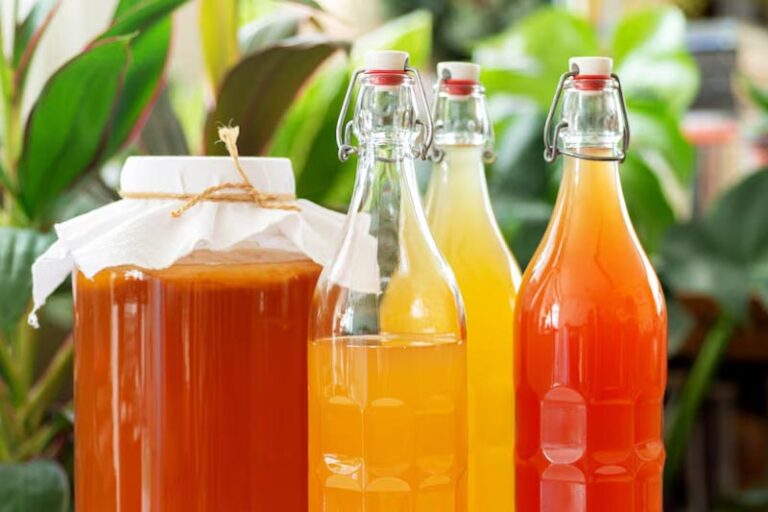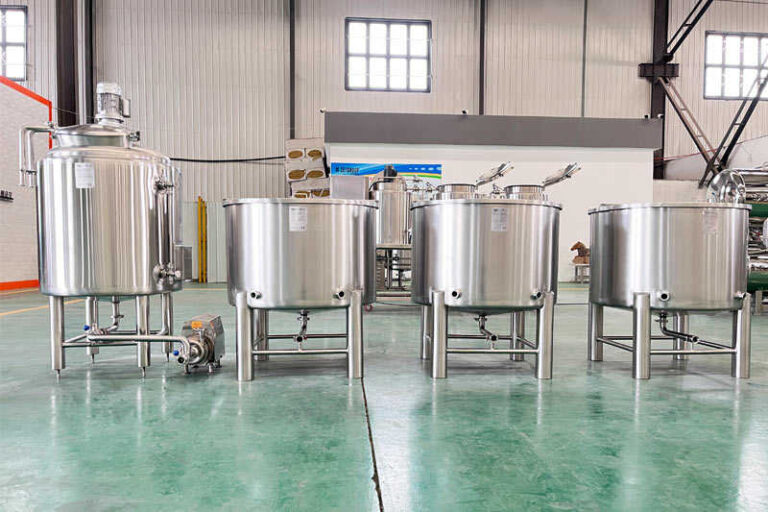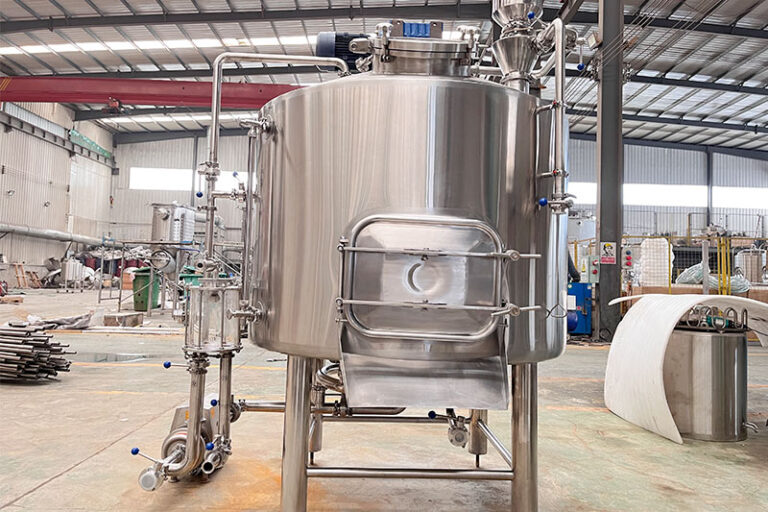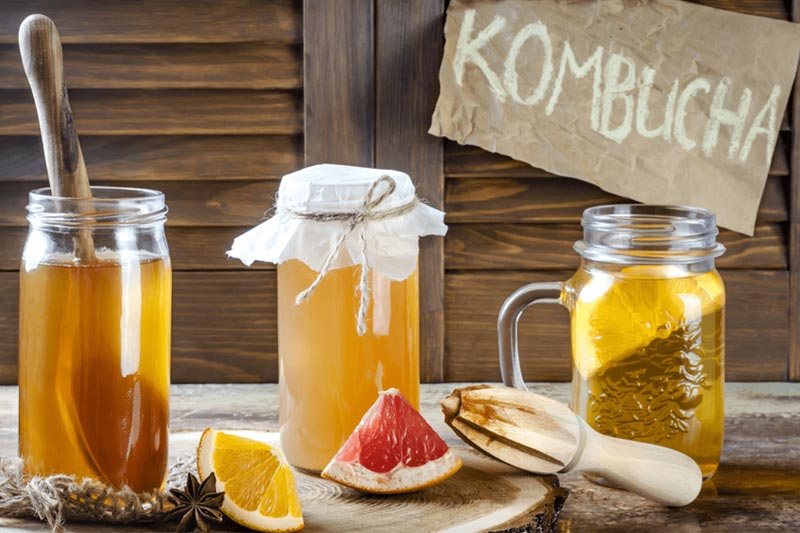Equipment and tools for brewing kombucha
Kombucha brewing equipment
- Material: The ideal container should be glass, ceramic, or food-grade plastic. Avoid metal containers, as metal may react with the acid in the tea, affecting the fermentation process and taste.
- Capacity: The size of the container depends on how much kombucha you plan to brew. Common home fermentation containers generally range from 1 liter to 5 liters.
- Wide-mouth design: The fermentation container is best with a wide-mouth design to facilitate the addition and removal of ingredients, and also facilitate gas exchange.
- Plate heat exchanger: Home brewers use cold water to cool the tea, while commercial brewers use heat exchangers to cool down with the help of a cold water supply.
- Electric heating elements: Specially designed electric heating elements are an indispensable part of commercial kombucha equipment.
- Other components: Pumps, pipes, valves, meters, and sensors can all help improve the efficiency of your kombucha production.
- Control system: The most suitable is a semi-automatic system, including automatic temperature control of the kettle, variable frequency drive of the pump, anti-dry burn protection, low-level flask, automatic water supply, and measurement options.

Common fermentation containers
- Glass bottles: Transparent, easy to observe the fermentation process, and will not react with acidic substances.
- Ceramic jars: Good insulation performance, suitable for fermentation, but you need to make sure that there are no harmful substances inside.
- Food-grade plastic barrels: Although not as common as glass and ceramic, some high-quality plastic barrels can also be used for kombucha fermentation.
Tea and sugar
- Tea: Traditionally, black tea or green tea is used as the base, but you can also try other types of tea, such as white tea or black tea. The type of tea will affect the taste and flavor of kombucha.
- Sugar: Sugar is an essential ingredient for brewing kombucha. Yeast and bacteria will convert sugar into alcohol and organic acids during the fermentation process. Commonly used sugars include white sugar, brown sugar, coconut sugar, etc. The choice of sugar will affect the speed and taste of fermentation.
Filter
- Fine mesh filter: Used to filter tea leaves and impurities.
- Gauze: If you choose to use a ceramic container, the gauze can be used as a lid to allow air circulation and prevent dust and debris from entering the container.
Fermentation temperature control equipment
- Thermometer: Used to monitor the temperature of the fermentation environment.
- Temperature control pad: If the fermentation environment temperature is too low, you can use a heating pad to keep the temperature within a suitable range.
Bottle tools
- Glass bottle: Used for secondary fermentation. It is best to choose a glass bottle with a sealed lid to generate bubbles.
- Funnel: Used to pour kombucha into the bottle to prevent liquid from spilling.
- Bottle cap: Seal the bottle mouth to ensure that gas does not leak during the fermentation process.
Cleaning and disinfection tools
- Non-toxic detergent: Used to clean all containers and tools.
- Edible alcohol: Used to disinfect utensils to ensure that there are no harmful bacteria.
- Hot water and clean cloth: Used to wipe the surface of the container.
Other auxiliary tools
- Wooden spoon or plastic spoon: Avoid using a metal spoon to stir the tea liquid.
- Measuring cup and measuring spoon: Accurately control the amount of tea and sugar to ensure consistency of each fermentation.
- pH test paper: Although not necessarily required, if you want to precisely control the pH of your kombucha, pH test paper can help you understand changes during the fermentation process.

How to Brew Kombucha Efficiently
Prepare Materials and Tools
- Tea: You can use black tea, green tea, or oolong tea. Black tea has a stronger taste, while green tea is more refreshing.
- Sugar: White sugar is a common raw material. The amount is usually 1 cup (200 grams) of sugar/1 liter of water.
- SCOBY and bacterial liquid: It is the core of Kombucha fermentation and is responsible for converting sugar into beneficial acids and gases.
- Starting liquid: When brewing for the first time, you can get the starting liquid from commercially available Kombucha or take it from the last batch of home-brewed Kombucha. Usually, you need to add about 100-150 ml of starting liquid for every 1 liter of tea.
- Water: Use filtered water to avoid chlorine in tap water that affects fermentation.
Brewing tea
- Boil water: Heat the required amount of water to near boiling.
- Brewing tea: Put 1-2 tea bags or 2-3 teaspoons of tea leaves in hot water and soak for 10-15 minutes to ensure that the tea concentration is moderate. You can adjust the brewing time and type of tea according to your personal preference.
- Add sugar: After the tea is brewed, add sugar while it is hot and stir until it is completely dissolved. Sugar is food for yeast and probiotics, so it cannot be omitted.
- Cool the tea: Set the tea aside to cool until the temperature drops to room temperature (about 25-30°C). Too high a temperature will kill the SCOBY.
Add SCOBY and starter liquid
- Prepare a container: Choose a clean glass bottle or large bowl, and make sure the container is large enough to hold at least 1-2 liters of tea.
- Add starter liquid: Pour the starter liquid into the container, about 100-150 ml/1 liter of tea.
- Put in SCOBY: Gently put the SCOBY into the cooled tea. The SCOBY usually floats on the water.
Fermentation
- Temperature control: The optimal temperature is 24°C-30°C. Too low a temperature will slow down fermentation, and too high a temperature may kill the bacteria. A fermentation box or heating pad can be used to maintain a constant temperature.
- Ventilation and covering: Cover the mouth of the container with a cloth or paper towel and secure it with a rubber band. The cloth allows air to circulate while keeping dust out. Keep in a cool place out of direct sunlight.
- Fermentation time: The fermentation time is usually 7-14 days, depending on the temperature and your taste preference. The longer the fermentation, the sourer the taste; if you like sweeter kombucha, you can have your first taste in 7-9 days.
Subsequent fermentation and storage
- Second fermentation: After the first fermentation is complete, filter the kombucha into a bottle and add fruits, herbs, or spices to taste. Seal and ferment for 1-3 days before refrigerating.
- Bottling and storage: After the second fermentation is completed, refrigerate in time to stop the fermentation process and prevent over-acidification.

How to choose the best kombucha brewing equipment?
Capacity and scale
- Personal brewing: If you only plan to brew a small amount of kombucha, you can choose a small brewing equipment, such as a 1-5 liter glass bottle or ceramic container.
- Home brewing: If you plan to brew a moderate amount of kombucha, usually choose a 5-20 liter glass container or a specially designed brewing keg.
- Commercial brewing: If you plan to produce a large amount of kombucha and sell it, you need a large-capacity brewing keg, usually 50 liters and above, and consider factors such as the degree of automation and hygiene standards.
Material
- Glass: Glass containers do not react with acidic liquids, can maintain the pure taste of kombucha, and are easy to clean, suitable for home brewing.
- Ceramic: Ceramic containers are also suitable for home use, but you need to make sure there is no coating or harmful chemicals. Some ceramic containers may not be suitable for large-scale production.
- Stainless steel: For commercial-scale production, stainless steel containers are durable and easy to clean, but they may react with acidic liquids, so you need to make sure to use food-grade stainless steel.
- Food-grade plastic: Some cheaper equipment may use plastic, but such materials are generally not recommended for long fermentation and may affect the taste of kombucha.
Functionality
- Cleanliness: Hygiene is very important in the brewing process of kombucha. Choosing containers and equipment that are easy to clean can help avoid the growth of harmful bacteria. Glass and stainless steel are generally easier to clean than plastic and are less likely to accumulate bacteria.
- Temperature control function: The brewing temperature of kombucha should be controlled between 21-29°C. Too high or too low temperatures will affect the fermentation process. If you brew kombucha in cold or hot areas, you can consider equipment with a temperature control function, or equipped with heating pads or heating devices.
- Fermentation time and management: The fermentation process of kombucha usually takes 7-14 days. Choosing the right equipment can help you better control the fermentation environment and avoid fermentation times that are too long or too short. Some equipment is equipped with adjustable thermometers and time controllers to help you accurately manage each batch.

Budget
- Low budget: If your budget is limited, you can choose simple hand-operated equipment, such as glass bottles, ceramic jars, or small stainless steel containers, which are relatively low-cost and suitable for small-batch home brewing.
- Medium-to-high budget: If your budget allows, you can choose equipment with temperature control, automatic stirring, and other functions, or even buy commercial brewing barrels, fermentation tanks, and other equipment.
FAQ
What is kombucha equipment?
Kombucha equipment is a special tool or appliance used to ferment kombucha, including fermentation tanks, temperature control devices, filters, etc., which helps users easily make kombucha at home or in a commercial environment.
How to clean kombucha equipment?
Use warm water and natural detergent to clean the equipment to avoid chemical residues.
Do not use hot water or dishwasher to clean equipment that comes into contact with SCOBY to avoid damaging the activity of SCOBY.
Make sure all equipment is thoroughly dry before use.
How to store unused equipment?
After cleaning, place it in a dry, dust-free place. It is recommended to use sealed bags or boxes to protect the equipment from dust and bacteria contamination.
How to avoid over-fermentation when brewing kombucha?
Observe the fermentation process: Check the taste of the fermented tea regularly, and start bottling when the sour taste is too strong.
Refrigerate: When the kombucha reaches the ideal taste, it can be transferred to the refrigerator for refrigeration, which will slow down the further fermentation process and prevent over-fermentation.

